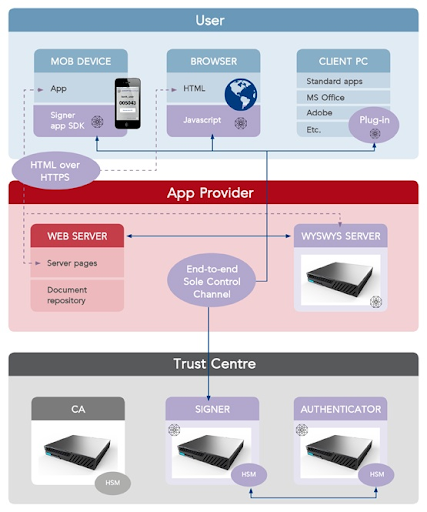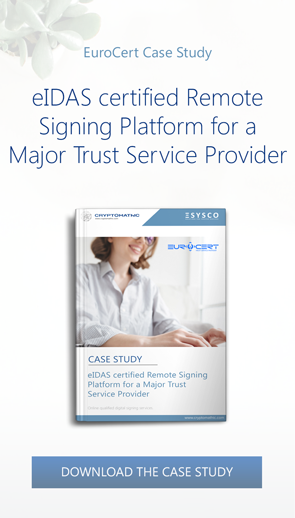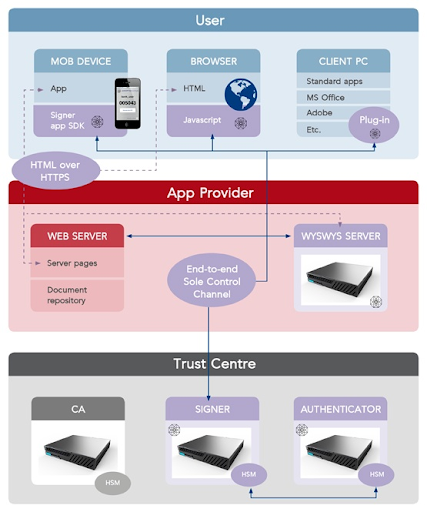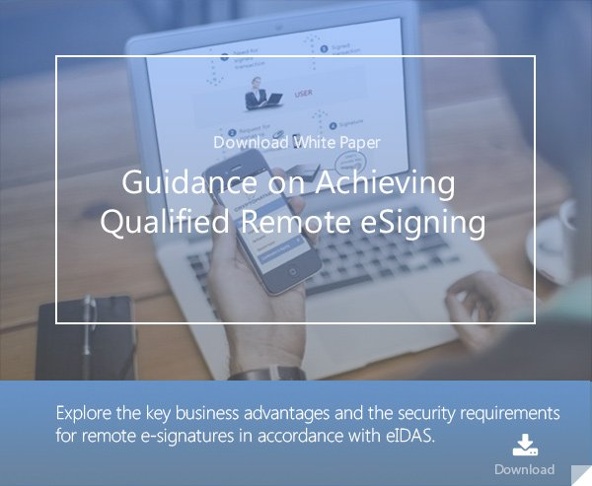3 min read
Integrating eIDAS Qualified Remote Signing Tools with Your Systems
Cryptomathic : 13. May 2022

The demand for remote digital signatures to enhance security and customer experience continues to grow across the EU, as the banking and financial sector moves forward with digitalization, global expansion, and technological transformation.
In this article, we present 3 integration options for Cryptomathic’s eIDAS qualified remote signing solution, Signer.
Digital Disruption
Banking customers have moved away from traditional branch-based banking to online and mobile alternatives in recent years. This is due to technological advancements and digital processes that streamline requirements, making it easier for both businesses and consumers to manage business needs and finances in parallel.
Customers expect services to be readily available, convenient, and technologically sophisticated. And this has increased the need for technology to remotely bridge the gap between customers and financial institutions.
Transitioning Towards Remote Digital Services
 Banks and financial institutions face significant obstacles in digitizing particular end-to-end digital services. This is where digital signature software comes into its own.
Banks and financial institutions face significant obstacles in digitizing particular end-to-end digital services. This is where digital signature software comes into its own.
The integration of eIDAS qualified digital signatures into various financial services as a form of online security and identity verification increases the level of trust between customers, organizations, and vendors. This includes third-party (fintech) companies.
Signer offers three integration options to suit your needs:
- Multi-purpose integration
- Core banking system integration module
- Integration-as-a-service
1. Multi-purpose Integrated Technology Solution
The first option is a multi-purpose solution. This provides a variety of APIs, software development kits (SDKs), and customisation options for secure, end-to-end digital communication chains. Visit our 'how it works' page for a detailed explanation.
Cryptomathic's eIDAS-certified remote signing technology satisfies this demand with its range of integration options while delivering the highest assurance level for multiple jurisdictions. We also supply back-end solutions and channel management applications, as well as front-end SDKs for easy, error-free, and secure integration.

Native Front-end Integrations
By using Cryptomathic’s SDKs in front-end applications, customers and application providers can simplify the implementation process. Cryptomathic provides APIs for signing and certificate handling, so it's easy to integrate our solution into mobile apps, desktop applications, and HTML over HTTPS communication. A special API allows companies to register a user and establish a certificate for a given policy.
End-to-end Channel Control
Cryptomathic features an SDK and API to secure the channel outside the customer's firewall-protected zone. A what-you-see-is-what-you-sign (WYSIWYS) server provides a pre-produced application for managing the signing process. Additional software, included in the SDK, allows users to control and protect the channel end-to-end. The Signer API is Common Criteria Certified
Backend
Cryptomathic’s technology for a native integration in the backend includes:
- RestFul API for the Registration Authority
- A customizable WYSIWYS server
- Support for a range of new or existing multi-factor authentication methods and systems
2. Integration Module for Digital Banking
The eConsent Module for Digital Banking Consent (DBC) is designed for integration with core banking systems that are already delivering digital services, such as mobile banking or online banking. Typically, such a system may already provide some notifications and manage some content, including documents.
This integration includes:
- A docker container for integration with core banking systems
- A built-in workflow management for advisors and signatories
- Mobile banking UX
- Seamless integration with core banking portals, including Crealogix, Temenos, or Avaloq
eConsent integrates with the core banking solution and can be triggered by processes to register a workload for advisors and signatories in an automated fashion. Messages can be sent to mobile devices to notify banking customers. For example, an individual who has applied for a loan can be notified on their mobile device that a document is available for signing.
3. As-a-Service Digital Verification and Signature Portal
The third type of integration available for Cryptomathic’s eIDAS qualified remote signing technology is a hosted digital identity and signing portal. This is available through Cryptomathic’s partners, such as ESYSCO’s Signature Portal “Signius”.
Rather than integrating APIs or code into existing software, signing can be performed by subscribing to a remote signing web portal. The portal's back end delivers functionality that allows users to file certain documents that can then be distributed automatically to a signatory or multiple signatories via an email message that notifies them that a document requires a signature. These documents could be uploaded manually or automatically by an uploader API that creates a file, typically a PDF file, and then sent and distributed to be signed.
Such digital signature portals include:
- Fully fledged portal with custom UI
- Document upload for multi-party signing and workflow orchestration
- Possible integration to custom KYC, Auth, or DMS
- Workflow management, such as batch-signing and multi-party signing
- User ID and user authentication
- Track and trace, allowing the advisor to see what has been signed and what is still awaiting a signature
- Custom branding
- Integration through API
- Integration with existing IdP
- App delivery
Contact Cryptomathic for further details on our integration options.
